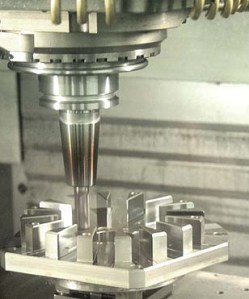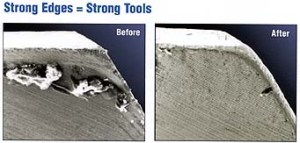Precision Edge Prep For Cutting Tools – Manufacturing Engineering Magazine
Appeared in Manufacturing Engineering Magazine – March 2006
Precision Edge Prep For Cutting Tools
 Oberg Industries (Freeport , PA), a precision manufacturer based in Western Pennsylvania, specializes in providing manufacturing and technology solutions to support customers in a variety of challenging markets.
Oberg Industries (Freeport , PA), a precision manufacturer based in Western Pennsylvania, specializes in providing manufacturing and technology solutions to support customers in a variety of challenging markets.
Oberg has succeeded by building on its 57-year tradition of developing creative solutions for the production of difficult-to-machine materials, ranging from tool steel and tungsten carbide to ceramic, stainless steel, titanium, and advanced alloys.
The company recently made significant investments in five-axis CNC machining centers that help to lower costs and improve quality while offering greater operating flexibility. The new equipment is capable of machining components to within 0.0002” (0.01 mm).
“The EMG process is more consistent than conventional methods because it applies the exact same edge preparation tool after tool.”
To exploit the benefits of the five-axis machining centers, Oberg switched from high-speed steel tooling to high-performance carbide tools, supplied by Siem Tool (Latrobe , PA).
Oberg used to regrind all of its tools internally, a costly process outside of its area of specialization. In 2000, the company began to outsource its regrinding to Siem Tool, and has almost eliminated internal costs associated with this work.
One step which Oberg has taken to optimize tool performance has been to require that all new tools and reground tools that Oberg orders from Siem Tool receive a special edge preparation treatment developed by Conicity Technologies (Cresco , PA).
The edge preparation process, called Engineered Micro-Geometry (or EMG), improves tool performance by eliminating microscopic defects in a tool’s cutting edge. The process employs a multi-axis CNC machine that prepares all cutting edges exactly the same, within a single tool and across batches of tools. The process can consistently and precisely shape edges to tolerances of 0.0002” (0.01 mm), several times more precisely than conventional honing methods.
“In some situations, this means a uniform hone along the entire cutting edge, but in other applications, it is better to vary the edge preparation. For example, the trailing edge can be honed differently from the cutting edge to minimize unwanted tool rubbing.”
Such controlled distribution of the edge prep makes the tool cut more efficiently with less heat generated, a benefit that is particularly important for Oberg. The controlled distribution of the edge prep also causes less material to be trapped between the tool and the workpiece, resulting in a smoother finish.
“Longer tool life is important for a number of reasons. It translates into cost savings for regrindings and replacements. With EMG edge prep, the interval between sharpening is typically extended by about 300%, says Robert Binner, Oberg’s toolroom manager. This is a great return on investment for the EMG process. Longer intervals between tool replacement also means less interruption to the production process and lower labor costs.”
More important are the indirect cost savings. “The edge prep greatly reduces tool breakage, which can cause a train wreck in our automated processes”, says Binner. “If a tool breaks in an unattended machine, and a hole is not properly cut, there is a domino effect that can cause other tools to break downstream.”
Such failures can be very expensive in terms of tool damage and loss of expensive parts, and subsequent problems can be difficult to correct. “With the carbide tools from Siem Tool and the EMG edge prep, we have been able to operate our high speed process with confidence, sometimes going weeks without replacing the drill bits and reamers,” Binner explains.
